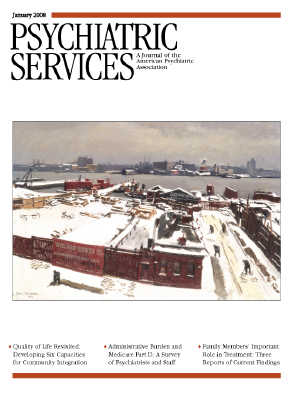Datapoints: Inpatient Utilization for Persons With Co-occurring Disorders
People with co-occurring mental and substance use disorders have been shown to be frequent users of inpatient care ( 1 ). Such studies, however, are limited to a single funding stream, type of disorder, or locale. Given recent emphasis on improving care for people with such co-occurring disorders, better estimates of inpatient utilization are important to aid design of effective, efficient public mental health and substance abuse services.
This column describes use of inpatient care in Delaware, Oklahoma, and Washington by clients who received at least one mental health or substance abuse service from the state mental health, substance abuse, or Medicaid agency in calendar year 1997 ( 2 ). Administrative files of these clients were matched across those agencies and categorized into three diagnostic groups: mental disorder only, substance use disorder only, and co-occurring mental and substance use disorders. Results were expected to differ across states because of potential differences in the case mix of patients served, types and amounts of services supported, regional variation in clinical practice, population dispersion and density, organization of each state authority administering services, managed care involvement, total dollars devoted to such services, and other factors.
Clients with co-occurring disorders were three to four times more likely to be hospitalized than clients with mental illness only and ten to 20 times more likely to be admitted than clients with a substance use disorder only. The average number of inpatient days per admitted client differed across states by more than 100% for each diagnostic group ( Figure 1 ). Despite the divergence in absolute values across states, in each state the length of inpatient stays were longest for admitted clients with mental illness only, followed by those with co-occurring disorders and those with a substance use disorder only. Yet across all clients, not just those admitted, the annual average number of hospital days per group was highest for the group with co-occurring disorders (data not shown).

Further study is needed to assess factors associated with higher admission rates for clients with co-occurring mental and substance use disorders—hospital stay limits, availability of inpatient and outpatient specialized programs, mechanisms to support linkages between outpatient and inpatient treatment, and other factors. It is also essential to determine whether such widely ranging inpatient care values represent divergent patient outcomes or another factor.
Acknowledgments and disclosures
The authors report no competing interests.
1. Finkelstein EA, Bray JW, Larson MJ, et al: Prevalence of and payments for mental health and substance abuse disorders in public and private sector health plans, in Mental Health, United States, 2002. Edited by Manderscheid RM, Henderson MJ. DHHS pub no SMA-3938. Rockville, Md, Center for Mental Health Services, 2004Google Scholar
2. Coffey RM, Dilonardo JD, Vandivort-Warren R, et al: Expenditures on Clients Receiving Treatment for Both Mental Illness and Substance-Use Disorders: Results From an Integrated Data Base of Mental Health, Substance Abuse, and Medicaid Agencies for Three States in 1997. Rockville, Md, Substance Abuse and Mental Health Services Administration, 2007Google Scholar



